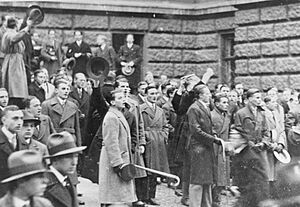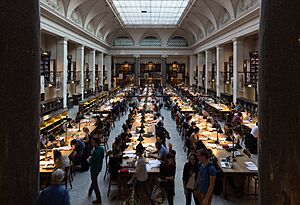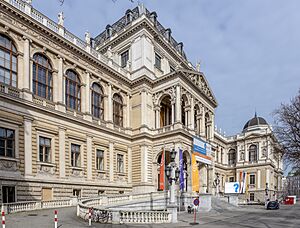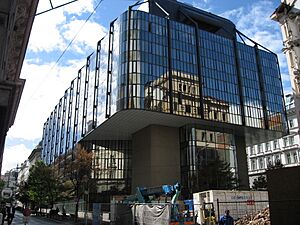University of Vienna facts for kids
|
Universität Wien
|
|
 |
|
| Latin: Universitas Vindobonensis | |
|
Former name
|
Alma Mater Rudolphina Vindobonensis |
|---|---|
| Type | Public |
| Established | 12 March 1365 |
| Budget | €691.5 million (2021) |
| Rector | Sebastian Schütze |
|
Academic staff
|
7,538 |
|
Administrative staff
|
3,043 |
|
Total staff
|
10,381 |
| Students | 88,900 (2021) |
| Postgraduates | 16,490 |
| 8,945 | |
| Location |
Vienna, Austria
48°12′47″N 16°21′35″E / 48.21306°N 16.35972°E |
| Campus | Urban |
| Colors | Blue and white |
| Affiliations |
|
 |
|
The University of Vienna (in German: Universität Wien) is a public research university in Vienna, the capital of Austria. It was founded by Duke Rudolph IV on March 12, 1365. This makes it the oldest university in the German-speaking world and one of the largest in Europe.
Over the centuries, the university has been home to many brilliant minds. Seventeen Nobel Prize winners have studied or taught here. Famous people connected to the university include the physicist Erwin Schrödinger, the composer Gustav Mahler, the founder of psychoanalysis Sigmund Freud, and the father of modern genetics, Gregor Mendel.
Contents
History of the University
From the Middle Ages to the 1700s
The university was founded in 1365 by Duke Rudolph IV. It is the third-oldest university in Central Europe, after universities in Prague and Kraków. At first, Pope Urban V did not approve a department for theology (the study of religion). This was likely because the Holy Roman Emperor, Charles IV, didn't want competition for his own university in Prague.
The Pope finally gave his full approval in 1384. This allowed the University of Vienna to become a full university with a Faculty of Catholic Theology. The first university building opened in 1385. It quickly grew to be the largest university in the Holy Roman Empire. By the mid-1400s, it had over 6,000 students.
In its early days, the university was run by professors and doctors, who elected a leader called a Rector. Students were grouped into four "Nations" and had less say in how the university was run.
The university faced challenges during the Reformation, a time of religious change in Europe. In 1551, Emperor Ferdinand I brought in the Jesuit Order, a Catholic religious group, to have more influence. By the mid-1700s, Empress Maria Theresa put the university under the control of the monarchy. Her son, Emperor Joseph II, made more changes. In 1782, he allowed Protestants and Jews to enroll, and he made German the official language for teaching.
Modern Times
After the Revolution of 1848, the university went through big changes. It gained more academic freedom, meaning professors and students could study and discuss ideas more freely. The beautiful main building you can see today on the Ringstraße was built between 1877 and 1884.
Women were first allowed to be full students in 1897, but only in philosophy. Other departments slowly opened up to women over the next few decades. In 1907, Elise Richter became the first woman to become a professor at the university.
During the 1930s, there were many political problems in Austria. After the Anschluss in 1938, when Austria became part of Germany under the Nazi regime, the university was changed. A large number of teachers and students were forced to leave for political or "racial" reasons.
After World War II ended in 1945, the university was reopened. In the following years, students and staff were given more say in how the university was run. Since 2002, the university has had more independence from the government.
Campus and Buildings
The University of Vienna doesn't have just one campus. Its buildings are spread out across more than sixty locations in the city of Vienna. The historic main building on the Ringstraße is the heart of the university and is often just called "die Uni."
Many other important buildings and lecture halls are nearby. These include the new Lecture Hall Complex (NIG) and the campus at the old General Hospital of Vienna. The Botanical Garden of the University of Vienna is in the city's Third District.
The university also owns the famous Vienna Observatory. It runs research centers in other parts of Austria for subjects like biology, astrophysics, and sports.
The University Library
The University Library is made up of a Main Library and 50 smaller libraries located in different departments. It is the largest library in Austria. While it mainly serves students and staff, anyone can visit and use the books in the reading rooms.
The library's collection has grown over many centuries. It started with books left by members of the university. Today, it has millions of items.
Library Facts (2023)
- Books: 7,782,104
- E-Journals: 155,072
- E-Books: 1,808,095
- Oldest Book: A handwritten Bible from 1392.
How the University is Organized
The University of Vienna is a public institution. Since 2002, it has been run by a board of governors and the professors, who make most of the major decisions.
Students can choose from 181 different degree programs. These include 55 bachelor's programs, 110 master's programs, and 13 doctoral programs. The university offers many master's programs taught in English, which attracts students from all over the world.
Faculties and Centers
The university is divided into 15 faculties and 5 centers. A faculty is a department that focuses on a specific area of study.
Faculties
- Faculty of Catholic Theology
- Faculty of Protestant Theology
- Faculty of Law
- Faculty of Business, Economics and Statistics
- Faculty of Computer science
- Faculty of Historical and Cultural Studies
- Faculty of Philological and Cultural Studies
- Faculty of Philosophy and Education
- Faculty of Psychology
- Faculty of Social sciences
- Faculty of Mathematics
- Faculty of Physics
- Faculty of Chemistry
- Faculty of Earth Sciences, Geography and Astronomy
- Faculty of Life sciences
Centers
- Centre for Translation studies
- Centre for Sport science and University Sports
- Centre for Molecular biology
- Centre for Microbiology and Environmental Systems Science
- Centre for Teacher Education
University Rankings
| University rankings | |
|---|---|
| Global – Overall | |
| ARWU World | 101-150 (2024) |
| QS World | 152 (2026) |
| THE World | 119 (2024) |
| USNWR Global | 208 (2024) |
| National – Overall | |
| USNWR National | 2 (2023) |
The University of Vienna is highly ranked, especially in Arts and Humanities and in Mathematics. Global rankings help show how a university compares to others around the world.
According to the 2024 QS World University Rankings by Subject, the university is among the world's best in many areas.
| Communication & Media Studies | 10 |
| Theology | 21 |
| History | 33 |
| Archaeology | 35 |
| Classics & Ancient History | 40 |
| Anthropology | 43 |
| Linguistics | 46 |
| Philosophy | 49 |
| Sociology | 55 |
| Arts & Humanities | 58 |
| Modern Languages | 62 |
| Psychology | 77 |
| English Language & Literature | 86 |
| Earth & Marine Sciences | 51-100 |
| Geology | 51-100 |
| Geography | 51-100 |
| Geophysics | 51-100 |
| Politics | 51-100 |
| Statistics & Operational Research | 51-100 |
| Biological Sciences | 96 |
| Law & Legal Studies | 97 |
| Mathematics | 97 |
| Agriculture & Forestry | 98 |
| Natural Sciences | 111 |
Famous People
Many famous people have studied or taught at the University of Vienna. They have made important contributions to science, art, and politics.
Nobel Prize Winners
Seventeen people connected to the university have won the Nobel Prize, one of the highest honors in the world.
- Robert Bárány, Medicine (1914)
- Richard Adolf Zsigmondy, Chemistry (1925)
- Julius Wagner-Jauregg, Medicine (1927)
- Hans Fischer, Chemistry (1930)
- Karl Landsteiner, Medicine (1930)
- Erwin Schrödinger, Physics (1933)
- Otto Loewi, Medicine (1936)
- Victor Francis Hess, Physics (1936)
- Richard Kuhn, Chemistry (1938)
- Max Perutz, Chemistry (1962)
- Karl von Frisch, Medicine (1973)
- Konrad Lorenz, Medicine (1973)
- Friedrich Hayek, Economics (1974)
- Elias Canetti, Literature (1981)
- Elfriede Jelinek, Literature (2004)
- Emmanuelle Charpentier, Chemistry (2020)
- Anton Zeilinger, Physics (2022)
Famous Students and Professors
Besides Nobel winners, many other well-known people have walked the halls of the university. These include founders of the Austrian School of economics like Carl Menger and Friedrich Hayek. Other famous names are the philosopher Karl Popper, the composer Anton Bruckner, and Austria's current president, Alexander Van der Bellen.
-
Huldrych Zwingli, a leader of the Reformation
-
Gregor Mendel, the father of genetics
-
Sigmund Freud, the founder of psychoanalysis
-
Hans Kelsen, a famous legal scholar
-
Gustav Mahler, a world-renowned composer
-
Erwin Schrödinger, a pioneer of quantum physics
-
Friedrich Hayek, a Nobel Prize-winning economist
See also
 In Spanish: Universidad de Viena para niños
In Spanish: Universidad de Viena para niños
- Education in Austria
- Klimt University of Vienna Ceiling Paintings
- Institute Vienna Circle
- List of medieval universities
- Ludwig Boltzmann Institut für Menschenrechte
- Roman Sebastian Zängerle
- Vienna Observatory
- Francis Stephen Award
- List of Jesuit sites

















